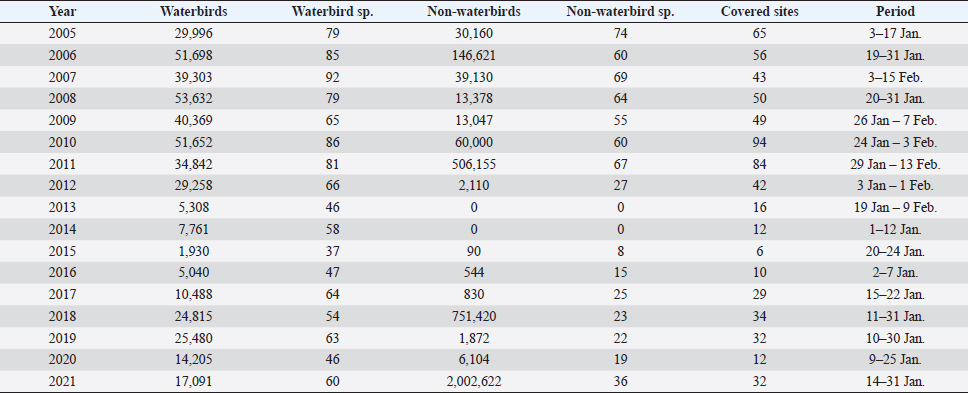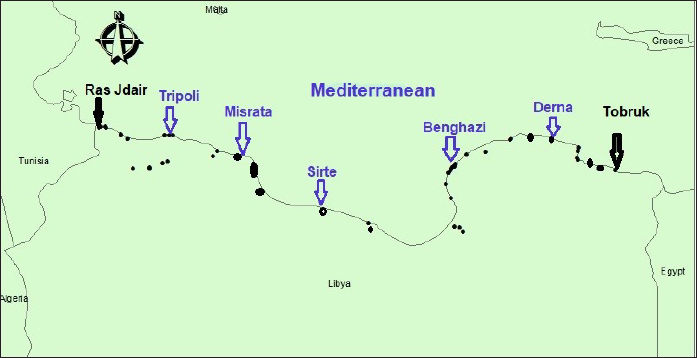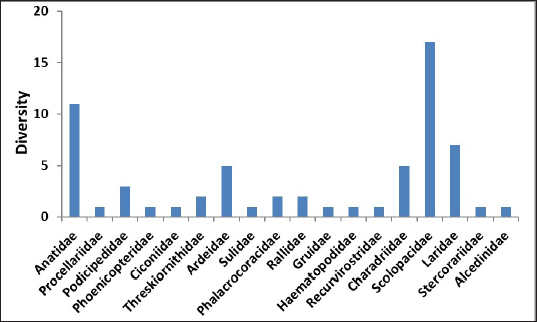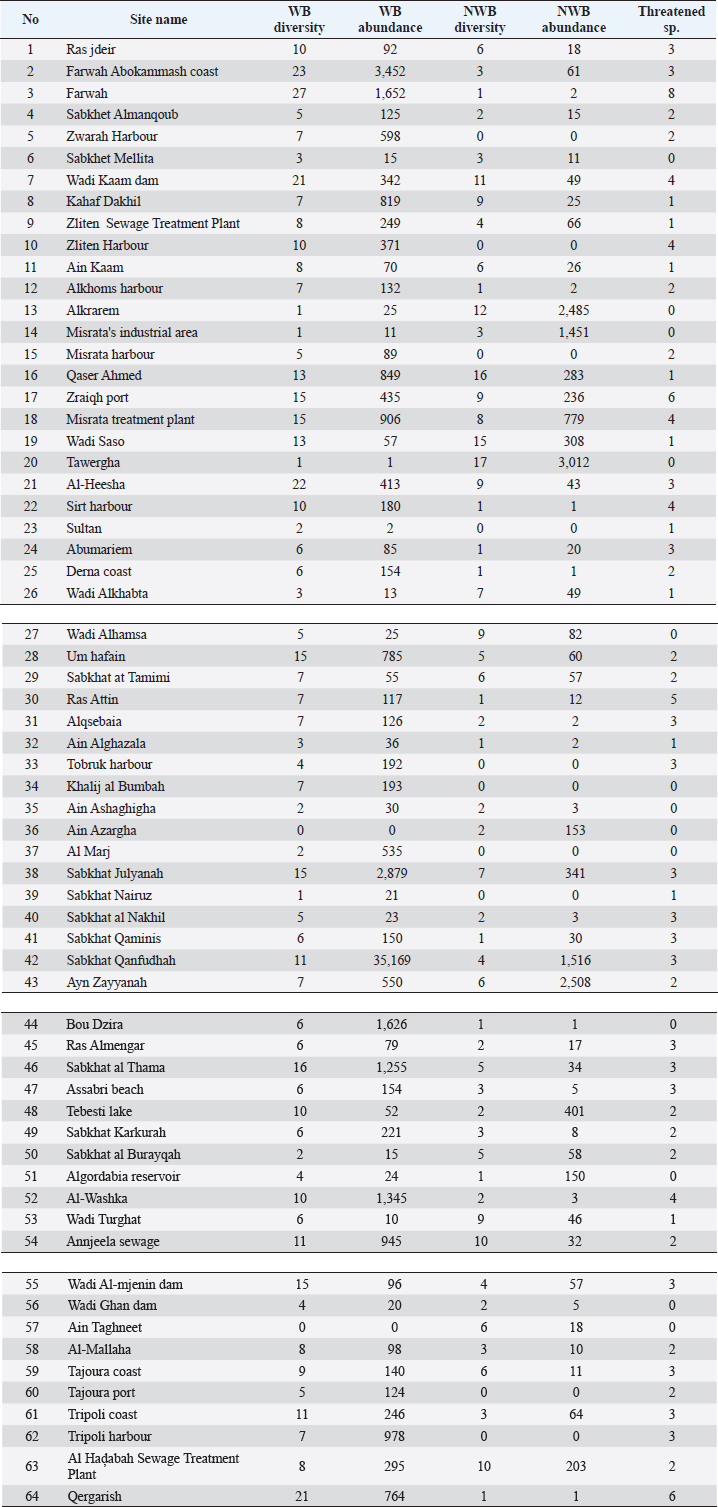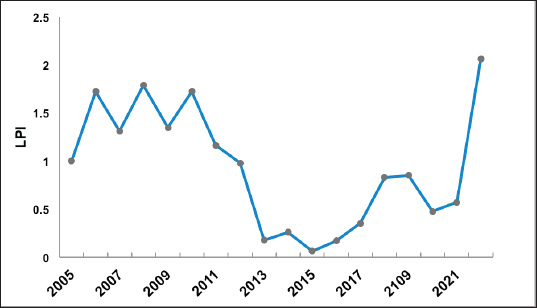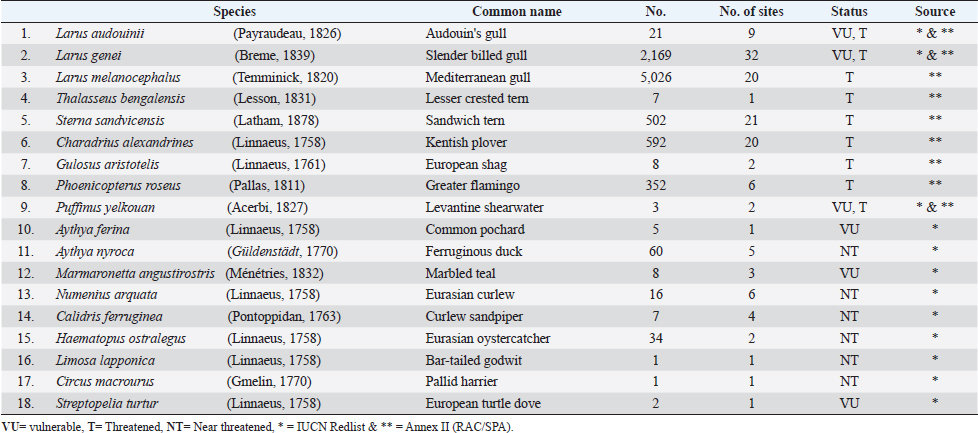
| Original Article | ||
Open Vet J. 2023; 13(4): 407-418 Open Veterinary Journal, (2023), Vol. 13(3): 407–418 Original Research Results of the eighteenth winter waterbird census in Libya in 2022Khaled Etayeb1,2,3*, Ashraf Galidana2, Ali Berbash2,4, Adulnasser Eisa2, Ali Al-kordi2, Elias Al-Helali2, Mahmoud Abuhajar2, Abdulati Alswyeb5, Hussien Abdulqader4,5, Naders Azabi6, Nader Ghriba6, Saleh Deryaq4,7, Abdulhafiz Algnaien4, Saleh Buirzayqah8, Murad Buijlayyil8, Muhanad Bujazlya4, Abdulmajid Hamhoom3, Abdulmoula Hamza9, Ehab Sharif3,10, Abdunaser Dayhum3,10, Abdulwahab Kammon3,10 and Ibrahim Eldaghayes3,101Department of Zoology, Faculty of Science, University of Tripoli, Tripoli, Libya 2Libyan Society for Birds (LSB), Libya 3National Research Center for Tropical and Transboundary Diseases (NRCTTD), Zintan, Libya 4Ministry of Environment, Tripoli, Libya 5Libyan Organization for Conservation of Nature, Misrata, Libya 6Bisida Society for Conservation of Farwa Island and Lagoon, Zwara, Libya 7Amwaje Society for Environment Conservation, Libya 8Alhaya Organization for Protection of Wildlife and Marine Organisms, Libya 9Department of Biology, Faculty of Education, University of Tripoli, Tripoli, Libya 10Faculty of Veterinary Medicine, University of Tripoli, Tripoli, Libya *Corresponding Author: Khaled Etayeb. Department of Zoology, Faculty of Science, University of Tripoli, Tripoli, Libya. Email: K.ETAYEB [at] uot.edu.ly Submitted: 01/01/2023 Accepted: 09/03/2023 Published: 06/04/2023 © 2023 Open Veterinary Journal
AbstractBackground: Libyan wetlands are diverse; the coastline of Libya, in particular, has different kinds of wetlands, such as salt marshes, bays, lakes, lagoons, and islands. These varieties in habitats provide good shelters and foraging sites for migratory birds during their journeys between Eurasia and Africa. Since the beginning of the Libyan winter census of waterbirds International waterbirds census (Libya IWC) in 2005, which continued regularly until 2012, it has had relatively the same performance in the number of covered sites. However, since 2013, due to the security situation that Libya has experienced due to wars and conflict, which negatively affected the quality of the IWC in Libya, the number of sites has dramatically decreased, reaching only six locations during the middle of the previous decade. Aim: The IWC 2022 aimed to count the birds along the Libyan coast from January 10 to 29. Methods: The census activities were conducted from dawn to dusk during the study period by using high-quality Telescopes, binoculars, and digital cameras for the documentation. Point transects method was used to cover the sites. Results: The results of this year showed that a total of 64 sites were covered, and 68 species of waterbirds were counted, with an abundance of 61,850 individuals. During the census period, a total of 52 non-waterbird species found in Wetlands were recorded, and the number of individuals was 14,836 birds. A total of 18 threatened species were observed during this survey, 12 of them are mentioned in the International Union for Conservation of Nature Red List, and nine species are mentioned in the regional activities center of specially protected areas annex II as threatened in the Mediterranean, where the species; Larus audouinii (Payraudeau, 1826), Larus genei (Breme, 1839), and Puffinus yelkouan (Acerbi, 1827) are mentioned in both of them. Conclusion: The lack of the number of ornithologists and bird watchers is still one of the factors affecting the quality of the IWC in Libya, as well as lack of funding remains an important factor that plays a major role in the success of the waterbirds census. Keywords: International waterbird census, Sites, Threatened species, Libya. IntroductionLibyan wetlands are diverse, from desert oases, fresh and saltwater springs, salt marshes, coastal lagoons, artificial reservoirs, and damps. In general, the majorities of wetlands in Libya are shallow salt marshes, dry or semi-dry most of the year, and sometimes connected to the sea (Sobkha) (Smart et al., 2006; EGA-RAC/SPA, 2012). The coastline of Libya, in particular, has different kinds of wetlands, such as salt marshes, bays, lakes, lagoons, and islands (Defos du Rau et al., 2003). These varieties in habitats provide good shelters and foraging sites for migratory birds during their journey from Europe and Asia to Africa and their journey back returns. Furthermore, some of these sites provide staging and nesting grounds for some species. However, with its dry climate, Libya is perceived as having relatively few wetlands and waterbirds. It is also, in terms of biodiversity one of the least known among Mediterranean countries, despite the published reports and papers (Azafzaf et al., 2005, 2006; Smart et al., 2006; Etayeb et al., 2007, 2012; EGA-RAC/SPA, 2012; Bourass et al., 2013). The winter census of waterbirds in Libya began in 2005; it has continued regularly during January of each year in the framework of the International Waterbirds Census (IWC). The IWC in Libya was conducted by local specialists and some ornithologists from outside the country (Tunisia, Italy, France, and the United Kingdom); this team worked from 2005 to 2011 under the supervision of the Environment General Authority (currently the Libyan Ministry of Environment) in cooperation with the Regional activities Center of Specially Protected Areas (RAC/SPA) and the Agreement on the Conservation of African-Eurasian migratory waterbirds, in coordination with Wetlands International. The first outputs of this cooperation were issued in two reports on wintering waterbirds in Libya (Azafzaf et al., 2005, 2006). Then these results were published in a scientific paper (Smart et al., 2006). Moreover, the census of wintering waterbirds in Libya continued until 2010, when the Atlas of wintering waterbirds of Libya was published (EGA-RAC/SPA, 2012). Then the results of the 2011 survey were published; it was the last year covering all the sites in Libya, where the total number was 84 (Bourass et al., 2013). Libya has experienced widespread security, which strongly affected the IWC. In 2012, about half of the sites were covered than in the previous year (Etayeb et al., 2012). In 2013, coordinated waterbird counts between North African countries noticed a limited coverage of the sites where 10 important wetlands were skipped due to security situations (Sayoud et al., 2017). From the year 2013 until 2021, the waterbirds census activities have continued were conducted by a team from the Libyan society of birds (LSB) with support from Mediterranean waterbird network in collaboration with Bisida Society and Bado Society in Zwara city, the Libyan Organization for Conservation of Nature (LOCN) and the Environment General Authority; despite the obstacles, security problems and unstable country situation that negatively affected the program. Consequently, the number of sites was at most 34; the least was only six sites around Tripoli in 2015. Although there was a slight improvement in the following years until 2021, this improvement did not lead to reaching the number of surveyed sites during the period from 2005 to 2011. However, the diversity and abundance of waterbirds and non-waterbirds were recorded; the results were undoubtedly affected by the inconvenient circumstances experienced by the winter census for birds in Libya (Table 1). This paper aims to present the results of the 18th IWC in Libya, which was conducted in January 2022 along the Libyan coastline under the supervision of the LSB in collaboration with the Libyan Ministry of Environment, National Research Center for Tropical and Transboundary Diseases and NGOs (LOCN, Bisida and Alhaya Organization for Protection of Wildlife and Marine Organisms). Material and MethodsThe winter census of waterbirds in Libya for 2022 was conducted from 10 to 29 January. The team covered all wetlands and waterbirds sites along the Libyan coast from Ras Jdair in the west to Tobruk in the east (Fig. 1). The census usually starts from early morning until evening. Sometimes to maintain the time, the team was split into two groups to cover the sites located at the same range and to avoid repeated counting of the same birds. The census was carried out using six binoculars, nine telescopes, and digital cameras for documentation. In addition, the point transects method (standing at a specific site and counting birds) was used to cover the areas (Volpato et al., 2009). To examine the population trend of waterbirds wintering in Libya from 2005 to 2022, the living planet index (LPI) was used. The use of LPI was started in 1997 by the World Wide Fund for Nature to investigate the changes in global biodiversity over time, especially for measuring the average trends of vertebrate populations (Loh et al., 2005). In this paper, the Chain method was used to calculate the index, where the logarithm of the ratio of the population of each pair of years was calculated using the formula: Where N=population size and t=years (time). The specific values of dt were generated for nt as: nt nt i=1 Finally, the index for waterbird populations in Libyan wetlands in a standard year t was calculated as: dt It=It-1 10 ResultsThe results of the winter survey of birds for 2022 showed that the total number of birds counted was 76,686 individuals, and the diversity of species reached 120 for the aquatic and non-aquatic birds. The abundance of waterbirds was 61,850 individuals belonging to 68 species classified under 18 families (Table 2). The number of species has varied among the families (1–17), where the family Scolopacidae is the most diverse, followed by the family Anatidae with 11 species. There are nine families represented by only one species each (Fig. 2). The abundance of waterbirds among the families was significantly varied, where the most considerable abundance was for the family Laridae (51,412) with a percentage of approximately 85%, while in some families, the number did not exceed one or two individuals. In terms of the diversity of species among the sites, it ranged from 0 to 27, where the largest assortment was in Farwa, and the highest abundance was in Sabkhat Qanfudhah with a total of 35,169 individuals (Table 3). Table 1. Results of IWC in Libya from 2005 to 2021.
Fig. 1. Covered sites during the IWC 2022. Table 2. Waterbirds and non-waterbirds were recorded in Jan. 2022 in Libya.
Fig. 2. Diversity of bird families during the IWC 2022 in Libya. The abundance of non-waterbirds was 14,836 individuals belonging to 52 species out of 25 families, the highest diversity was in the family Muscicapidae, represented by 12 species, and the abundance of those species was 474 individuals. The largest abundance of non-waterbird species was 12,740 for the family Sturnidae, although it has represented by only one species: Common Starling Sturnus vulgaris (Linnaeus, 1758) (Table 2). The diverse species of non-waterbirds varied between sites (0–17), with the highest diversity being in the Tawergha region and in terms of abundance, which was 3,012, while a total of 10 sites with no records of non-waterbirds (Table 3). Using the LPI Chain method revealed that the population index of the wintering water birds in Libya in 2022 has increased by up to more than 100%. The period from 2005 to 2009 showed a fluctuation of rising between 50% and 100%, while, for the period from 2013 to 2021, the index showed a dramatic decrease of 25% to 100%, particularly in the year 2015 (Fig. 3). This survey observed a total of 18 endangered (Threatened) bird species; 16 are aquatic, and 2 are non-aquatic birds. This classification is depending on the International Union for Conservation of Nature (IUCN Red-list) and the Annex II of the (RAC/SPA-MAP/UNEP). Moreover, six of them are evaluated as threatened species, the other six species are near threatened, and the vulnerable, endangered species are six (Table 4). Those species have been recorded in 79.6% of sites (n=64). Table 3. Number of birds in the covered sites during the IWC 2022 in Libya.
Fig. 3. LPI of wintering water birds in Libya 2005–2022. DiscussionThe results of IWC 2022 in Libya are generally reasonable compared to the previous years (2013–2021), but they can be compared with the results of the beginning of the survey in Libya during the years from 2005 to 2012 (Azafzaf et al., 2005, 2006; Smart et al., 2006; Etayeb et al., 2007; Hamza et al., 2008; EGA-RAC/SPA, 2012). The main reason for the improvement is related to the number of covered sites in which the census is conducted, as it decreased significantly during the years 2013–2021, with a total of six sites in 2015, while in 2010, the number of covered sites reached 94 (EGA-RAC/SPA, 2012). The highest abundance of waterbirds in 2008 was 53,632 (Hamza et al., 2008), and the highest diversity was 92 in 2007 (Etayeb et al., 2007), compared to the results of IWC 2022, where 68 species were recorded with the abundance of 61,850 birds, this indicated good improvement in term of diversity and abundance of species, as well as, the LPI emphasized this improvement in 2022, where it was increased up to more than 100% from the point of starting in 2005. However, under normal circumstances, Libya is considered less diverse and abundant of birds compared to its neighboring countries such as Tunisia and Egypt (Smart et al., 2006), through which major migration routes pass, as the first route passes along the Nile River and the other one passes through Italy and Sicily to Tunisia (Berthold, 2001). Table 4. Threatened species recorded during the IWC 2022 in Libya.
Although the family Scolopacidae was represented by the highest diversity (17 species), followed by the Anatidae family with 11 species, in terms of abundance, the family Laridae was the highest, represented by seven species, including gull species which are marine birds, and the covered sites are along the coastline. Moreover, the important factor that explains the abundance of gulls in large numbers is the presence of dumping grounds in some sabkha; this attracts high numbers of gulls that reach tens of thousands because these species are mainly scavengers and prefer the putrescible-waste landfills (Belant, 1997). One of the most important areas where there are many gulls is Sabkhat Qanfudhah, the largest dumps in the Benghazi region. The number of Black-headed gull Chroicocephalus ridibundus exceeded 15,000, and more than 9,000 individuals of the yellow-legged gull Larus michahellis were recorded. However, the diversity and abundance of bird species are usually related to habitat type and preference factors (Jones, 2001). Recording and observing the globally threatened species is one of four criteria used by the global network of important bird areas (IBAs) and the IUCN to identify the importance of the sites for biodiversity in general and birds in particular (BirdLife International, 2014; IUCN, 2016). This study recorded a total of 18 threatened species with varying numbers in 51 sites out of 64. These records give importance to the sites where threatened species were recorded. Moreover, such recordings support decision-makers in declaring protected areas in addition to other reasons or purposes for protection. However, recording one endangered species is sufficient to give the area importance and be a priority for protection (Day et al., 2012; Stolton et al., 2013). Regarding sites, depending on the registered threatened species, Farwa is considered the most important site as an IBA and marine protected area (MPA); indeed, it has been declared as MPA by the resolution of the Minister of Agriculture, Animal and Marine No. 22 of 2009. Ain Alghazala also was declared as MPA in 2011, although this study found only one threatened species. This finding is considered supportive of the protection decision, in addition to the presence of other important species of fish recorded in the area. Overall, this study strongly recommends that the rest of the sites listed in the present study should be protected and managed, as well as implementing a comprehensive study to address the other biodiversity components. AcknowledgmentsThe authors of this paper are grateful to Laura Dami, the coordinator of Med-Waterbirds Network based in Tour du Valat, and also to AFD/FEEM project for financial and logical support. Many thanks to Dr. Huda Alhdad (head of the Benghazi branch, Ministry of Environment) for good coordination in conducting the census in Benghazi. Special thanks to Mr. Adel Aburas (London, Wood Green, UK) for proofreading the manuscript. ReferencesAzafzaf, H., Baccetti, N., Defos du Rau, P., Dlensi, H., Essghaier, M.F., Etayeb, K., Hamza, A. and Smart, M. 2005. Report on an ornithological survey in Libya from 3 to 17 January 2005 (Unpublished report). Tunis, Tunisia: Regional Activities Centre/Special Protected Areas (MAP/UNEP), Environment General Authority, Libya, and African-Eurasian Waterbird Agreement (UNEP/AEWA). Azafzaf, H., Baccetti, N., Defos du Rau, P., Dlensi, H., Essghaier, M.F., Etayeb, K., Hamza, A. and Smart, M. 2006. Report on an Ornithological Survey in Libya from 19 to 31 January 2006. Cyclostyled report to the Regional Activity Centre/Special protected Areas (MAP/UNEP), Environment General Agency, Libya and to the African-Eurasian Waterbird Agreement (UNEP/AEWA). Belant, J.L. 1997. Gulls in urban environments: landscape-level management to reduce conflict. Landsc. Urban. Plan. 38, 245–258. Berthold, P. 2001. Bird migration, a general survey, 2nd ed. Oxford, UK: Oxford University Press, p: 253. BirdLife International. 2014. Important bird and biodiversity areas: a global network for conserving nature and benefiting people. Cambridge, UK: BirdLife International. Bourass, E., Baccetti, N., Bashimam, W., Berbash, A., Bou Zainen, M., De Faveri, A., Galidan, A., Saied, A.M., Yahia, J. and Zenatello, M. 2013. Results of the seventh winter waterbird census in Libya, January-February 2011. Bull. Afr. Bird. Club. 20, 20–26. Day, J., Dudley, N., Hockings, M., Holmes, G., Laffoley, D., Stolton S. and Wells, S. 2012. Guidelines for applying the IUCN protected area management categories to marine protected areas. Gland, Switzerland: IUCN, p: 36. Defos du Rau, P., Essghaier, M.F.A. and Etayeb, K. 2003. Inventaire preliminaire des zones humides cotieres de Libya. Faune. Sauvage. (ONCFS). 259, 44–48. EGA-RAC/SPA Waterbird Census Team. 2012. Atlas of wintering waterbirds of Libya, 2005-2010. Ben Arous, Tunisia: Imprimerie COTIM. Etayeb, K.S., Berbash, A., Bashimam, W., Bouzainen, M., Galidana, A., Saied, M., Yahia, J. and Bourass, E. 2015. Results of the eighth winter waterbird census in Libya in January 2012. Biodiver. J. 6(1), 245–252. Etayeb, K.S., Essghaier, M.F., Hamza, A., Smart, M., Azafzaf, H., Defos du Rau, P. and Dlensi, H. 2007. Report on an ornithological survey in Libya from 3 to 15 February 2007. EGA-AEWA-RAC/SPA-MAP-UNEP, p: 46. Hamza, A., Saied, A., Bourass, E., Yahya, J., Smart, M., Baccetti, N., Defos, P., Dlensi, H. and Azafzaf, H. 2008. Final report on a fourth winter ornithological survey in Libya, 20-31 January 2008. EGA-AEWA-RAC/SPA-MAP-UNEP, p: 31. IUCN. 2016. A global standard for the identification of key biodiversity areas, version 1.0, 1st ed. Gland, Switzerland: IUCN. Jones, J. 2001. Habitat selection studies in avian ecology: a critical review. The Auk. 118(2), 557–562. Loh, J., Green, R.E., Ricketts, T., Lamoreux, J., Jenkins, M., Kapos, V. and Randers, J. 2005. The living planet index: using species population time series to track trends in biodiversity. Philos. Trans. R. Soc. B. 360, 289–295. Sayoud, M.S., Salhi, H., Chalabi, B., Allali, A., Dakki, M., Qninba, A., El-Agbani, M.A., Azafzaf, H., Feltrup-Azafzaf, C., Dlensi, H., Hamouda, N., Abdel Latif Ibrahim, W., Asran, H., Abu Elnoor, A., Ibrahim, H., Etayeb, K., Bouras, E., Bashaimam, W., Berbash, A., Deschamps, C., Mondain-Monval, J.Y., Brochet, A.L., Véran, S. and Defos du Rau, P. 2017. The first coordinated trans-North African mid-winter waterbird census: the contribution of the international waterbird census to the conservation of waterbirds and wetlands at a biogeographical level. Biol. Conserv. 206, 11–20. Smart, M., Essghaier, M.F., Etayeb, K., Hamza, A., Azafzaf, H., Baccetti, N. and Defos Du Rau, P. 2006. Wetlands and wintering waterbirds in Libya, January 2005 and 2006. Wildfowl. Wetl. Trust. 56, 172–191. Stolton, S., Shadie, P. and Dudley, N. 2013. IUCN WCPA best practice guidance on recognising protected areas and assigning management categories and governance types, best practice protected area guidelines series no. 21. Gland, Switzerland: IUCN, p: 143. Volpato, G.H., Lopes, E.V., Mendonça, L.B., Boçon, R., Bisheimer, M.V., Serafini, P.P. and Anjos, L.D. 2009. The use of the point count method for bird survey in the Atlantic forest. Zoologia 26(1), 74–78. | ||
| How to Cite this Article |
| Pubmed Style Etayeb K, Galidana A, Berbash A, Eisa A, Al-kordi A, Al-Helali E, MA, Alswyeb A, Abdulqader H, Azabi N, Ghriba N, Deryaq S, Algnaien A, Buirzayqah S, Buijlayyil M, Bujazlya M, Hamhoom A, Hamza A, ES, Dayhum A, Kammon A, Eldaghayes I. Results of the eighteenth winter waterbird census in Libya (IWC), January 2022. Open Vet J. 2023; 13(4): 407-418. doi:10.5455/OVJ.2023.v13.i4.2 Web Style Etayeb K, Galidana A, Berbash A, Eisa A, Al-kordi A, Al-Helali E, MA, Alswyeb A, Abdulqader H, Azabi N, Ghriba N, Deryaq S, Algnaien A, Buirzayqah S, Buijlayyil M, Bujazlya M, Hamhoom A, Hamza A, ES, Dayhum A, Kammon A, Eldaghayes I. Results of the eighteenth winter waterbird census in Libya (IWC), January 2022. https://www.openveterinaryjournal.com/?mno=135473 [Access: April 19, 2024]. doi:10.5455/OVJ.2023.v13.i4.2 AMA (American Medical Association) Style Etayeb K, Galidana A, Berbash A, Eisa A, Al-kordi A, Al-Helali E, MA, Alswyeb A, Abdulqader H, Azabi N, Ghriba N, Deryaq S, Algnaien A, Buirzayqah S, Buijlayyil M, Bujazlya M, Hamhoom A, Hamza A, ES, Dayhum A, Kammon A, Eldaghayes I. Results of the eighteenth winter waterbird census in Libya
(IWC), January 2022. Open Vet J. 2023; 13(4): 407-418. doi:10.5455/OVJ.2023.v13.i4.2 Vancouver/ICMJE Style Etayeb K, Galidana A, Berbash A, Eisa A, Al-kordi A, Al-Helali E, MA, Alswyeb A, Abdulqader H, Azabi N, Ghriba N, Deryaq S, Algnaien A, Buirzayqah S, Buijlayyil M, Bujazlya M, Hamhoom A, Hamza A, ES, Dayhum A, Kammon A, Eldaghayes I. Results of the eighteenth winter waterbird census in Libya
(IWC), January 2022. Open Vet J. (2023), [cited April 19, 2024]; 13(4): 407-418. doi:10.5455/OVJ.2023.v13.i4.2 Harvard Style Etayeb, K., Galidana, . A., Berbash, . A., Eisa, . A., Al-kordi, . A., Al-Helali, . E., , . M. A., Alswyeb, . A., Abdulqader, . H., Azabi, . N., Ghriba, . N., Deryaq, . S., Algnaien, . A., Buirzayqah, . S., Buijlayyil, . M., Bujazlya, . M., Hamhoom, . A., Hamza, . A., , . E. S., Dayhum, . A., Kammon, . A. & Eldaghayes, . I. (2023) Results of the eighteenth winter waterbird census in Libya
(IWC), January 2022. Open Vet J, 13 (4), 407-418. doi:10.5455/OVJ.2023.v13.i4.2 Turabian Style Etayeb, Khaled, Ashraf Galidana, Ali Berbash, Adulnasser Eisa, Ali Al-kordi, Elias Al-Helali, Mahmoud Abuhajar, Abdulati Alswyeb, Hussien Abdulqader, Nader Azabi, Nader Ghriba, Saleh Deryaq, Abdulhafiz Algnaien, Saleh Buirzayqah, Murad Buijlayyil, Muhanad Bujazlya, Abdulmajid Hamhoom, Abdulmoula Hamza, Ehab Sharif, Abdunaser Dayhum, Abdulwahab Kammon, and Ibrahim Eldaghayes. 2023. Results of the eighteenth winter waterbird census in Libya
(IWC), January 2022. Open Veterinary Journal, 13 (4), 407-418. doi:10.5455/OVJ.2023.v13.i4.2 Chicago Style Etayeb, Khaled, Ashraf Galidana, Ali Berbash, Adulnasser Eisa, Ali Al-kordi, Elias Al-Helali, Mahmoud Abuhajar, Abdulati Alswyeb, Hussien Abdulqader, Nader Azabi, Nader Ghriba, Saleh Deryaq, Abdulhafiz Algnaien, Saleh Buirzayqah, Murad Buijlayyil, Muhanad Bujazlya, Abdulmajid Hamhoom, Abdulmoula Hamza, Ehab Sharif, Abdunaser Dayhum, Abdulwahab Kammon, and Ibrahim Eldaghayes. "Results of the eighteenth winter waterbird census in Libya
(IWC), January 2022." Open Veterinary Journal 13 (2023), 407-418. doi:10.5455/OVJ.2023.v13.i4.2 MLA (The Modern Language Association) Style Etayeb, Khaled, Ashraf Galidana, Ali Berbash, Adulnasser Eisa, Ali Al-kordi, Elias Al-Helali, Mahmoud Abuhajar, Abdulati Alswyeb, Hussien Abdulqader, Nader Azabi, Nader Ghriba, Saleh Deryaq, Abdulhafiz Algnaien, Saleh Buirzayqah, Murad Buijlayyil, Muhanad Bujazlya, Abdulmajid Hamhoom, Abdulmoula Hamza, Ehab Sharif, Abdunaser Dayhum, Abdulwahab Kammon, and Ibrahim Eldaghayes. "Results of the eighteenth winter waterbird census in Libya
(IWC), January 2022." Open Veterinary Journal 13.4 (2023), 407-418. Print. doi:10.5455/OVJ.2023.v13.i4.2 APA (American Psychological Association) Style Etayeb, K., Galidana, . A., Berbash, . A., Eisa, . A., Al-kordi, . A., Al-Helali, . E., , . M. A., Alswyeb, . A., Abdulqader, . H., Azabi, . N., Ghriba, . N., Deryaq, . S., Algnaien, . A., Buirzayqah, . S., Buijlayyil, . M., Bujazlya, . M., Hamhoom, . A., Hamza, . A., , . E. S., Dayhum, . A., Kammon, . A. & Eldaghayes, . I. (2023) Results of the eighteenth winter waterbird census in Libya
(IWC), January 2022. Open Veterinary Journal, 13 (4), 407-418. doi:10.5455/OVJ.2023.v13.i4.2 |





